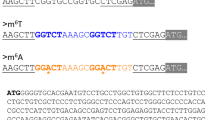Abstract
A stably transformed BHK cell line, engineered to produce a human transferrin half-molecule under the control of a mouse metallothionein (MT) promoter, was used as a model system to develop strategies to increase inducible recombinant protein production. Gene expression regulated by the MT promoter is induced by heavy metals (e.g. Zn+2 or Cd+2) in a dose dependent fashion. However, at high concentrations these metals are toxic to cells. Culture protocols which balance these counteractive effects are needed to maximize transferrin production. Fully induced cells produced up to 0.7 pg transferrin/cell·h, a 3-fold increase in production over uninduced levels. Cell growth was inhibited at Cd+2 dosages above 1 fmol/cell; prolinged exposure at this dosage was cytotoxic. Cell specific transferrin productivities decreased within 48 h following induction with Cd+2 although cell-associated Cd+2 levels remain high. Further addition of Cd+2 to cultures restored cell specific transferrin production rates. This suggests that cell associated Cd+2 is sequestered into a form which does not stimulate the MT promoter. Cd+2 dosing regimes which maintained cell associated Cd+2 concentrations between 0.2 and 0.35 fmol/cell ensured cell growth and high cell specific productivities which maximized final product titers. For routine batch culture, initial Cd+2 loadings of 0.8 fmol/cell gave near-maximum transferrin production levels. For extended culture, repeated small doses of 0.5 fmol/cell every 24 to 48 h maximized transferrin synthesis with this cell line.
Similar content being viewed by others
References
Andrews GK, Adamson ED (1987) Butyrate selectively activates the metallothionein gene in teratocarcinoma cells and induces hypersensitivity to metal induction, Nucleic Acids Res., 15: 5461–5475.
Durnam DM, Palmiter RD (1984) Induction of metallothionein-I mRNA in cultured cells by heavy metals and iodoacetate: evidence for gratuitous inducers, Mol. Cell. Biol., 4: 484–491.
Funk WD et al. (1990) Expression of the amino half-molecule of human serum transferrin in cultured cells and characterization of the recombinant protein, Biochem, 29: 1654–1660.
Foulkes EC (1988) On the mechanism of transfer of heavy metals across cell membranes, Toxicol., 52: 263–272.
Foulkes EC, Blanck S (1990) Acute cadmium uptake by rabbit kidneys: mechanisms and effects, Toxicol. Appl. Pharmaco., 102: 464–473.
Hamer DH (1986) Metallothionein, Ann. Rev. Biochem., 55: 913–951.
Hansen P (1991) Heavy metal determination using potentiometric stripping analysis, American laboratory, April, 52–58.
Jagner D et al. (1981) Simultaneous determination of cadmium and lead in whole blood in serum by computerized potentiometric stripping analysis, Anal. Chem., 53: 1406–1412.
Jervis EJ and Kilburn DG (1991) Rapid immunoassay technique for process monitoring of animal cell fermentations, Biotechnol. Prog. 7: 28–32.
Muller L (1986) Consequences of cadmium toxicity in rat hepatocytes: mitochondrial dysfunction and lipid peroxidation, Toxicol., 40: 285–295.
Mustafa MG et al. (1971) Interference of cadmium ion with oxidative metabolism of alveolar macrophages, Arch. Intern. Med., 127: 1050–1058.
Schroeder J and Cousins R (1990) Interleukin 6 regulates metalothionein gene expression and zinc metabolism in hepatocyte monolayer cultures, Proc. Natl. Acad. Sci. USA, 87: 3137–3141.
Author information
Authors and Affiliations
Rights and permissions
About this article
Cite this article
Jervis, E., Kilburn, D.G. Strategies for maximizing metallothionein promoter regulated recombinant protein production in mammalian cell cultures. Cytotechnology 21, 217–223 (1996). https://doi.org/10.1007/BF00365344
Received:
Accepted:
Issue Date:
DOI: https://doi.org/10.1007/BF00365344




